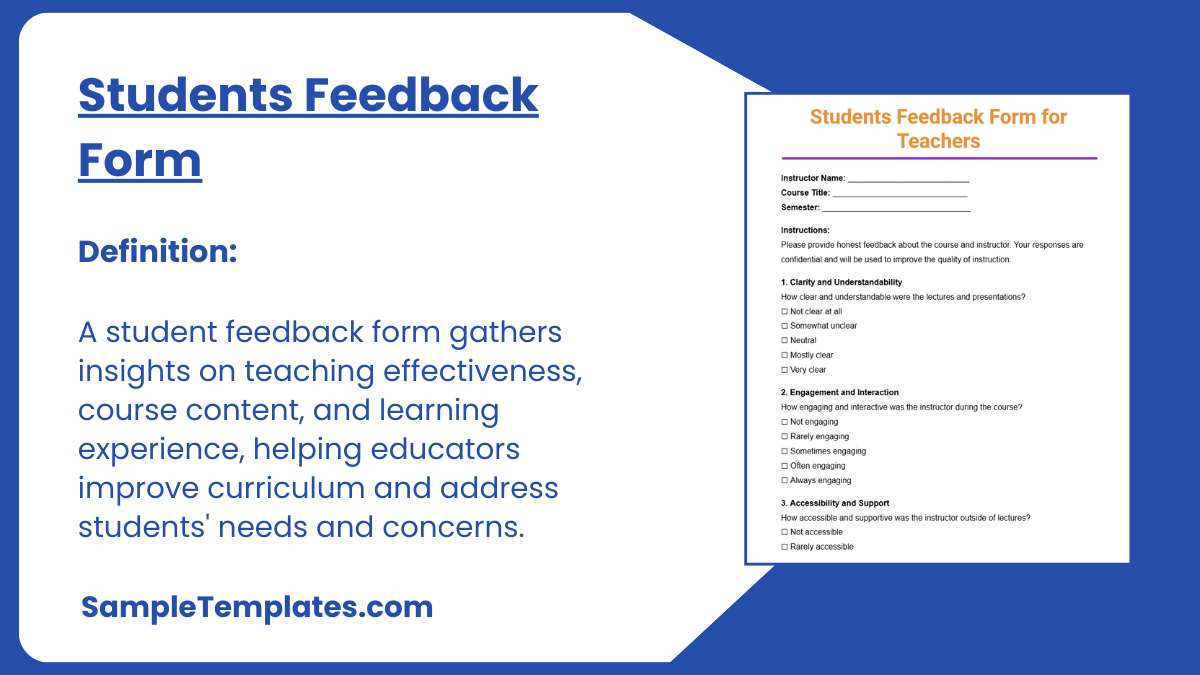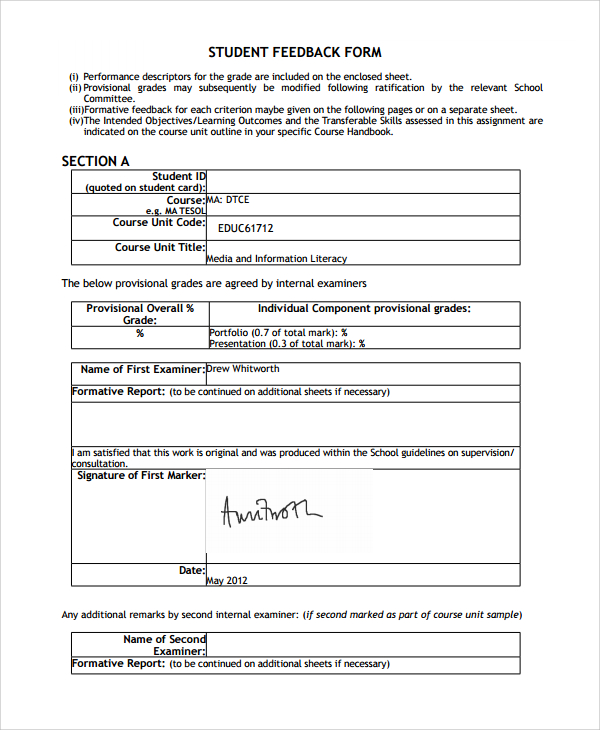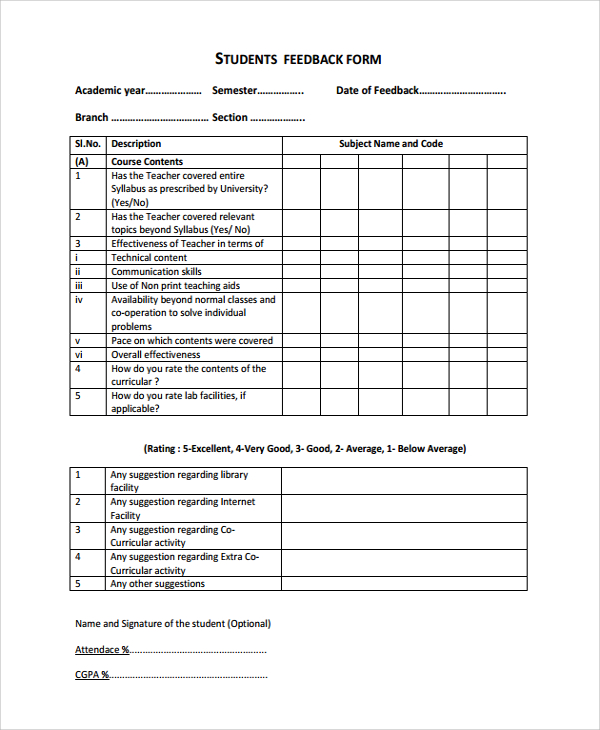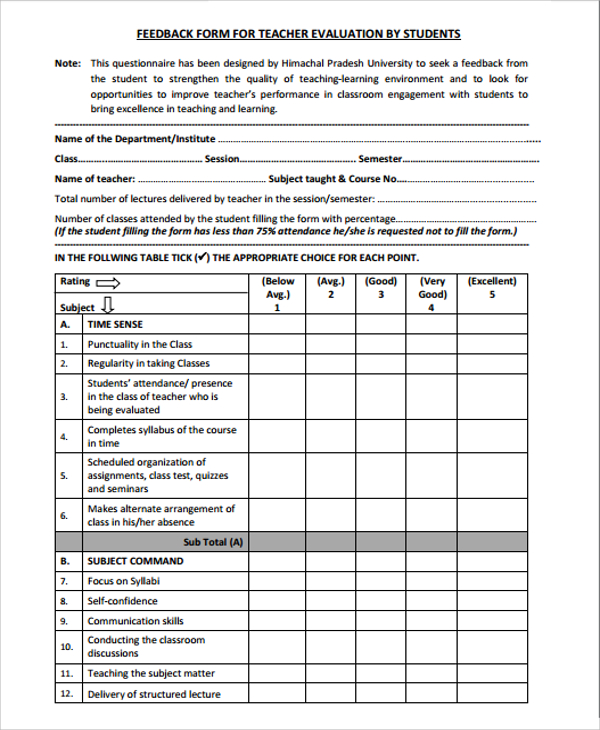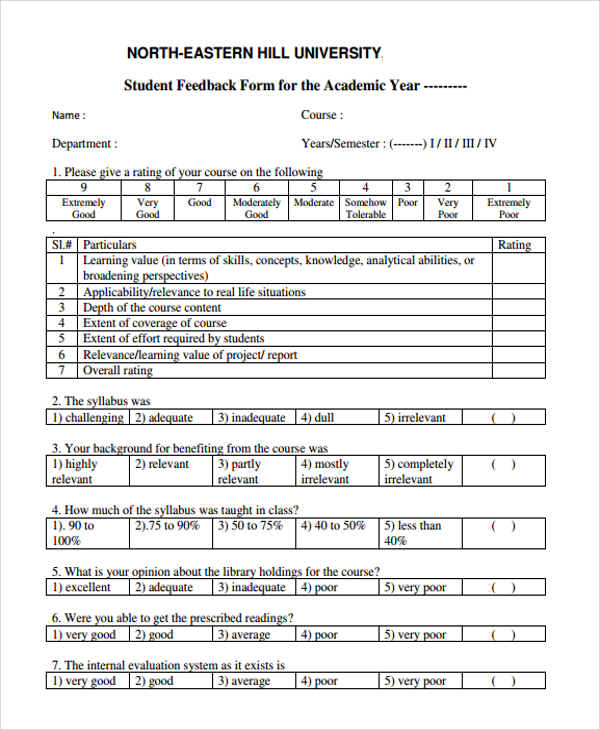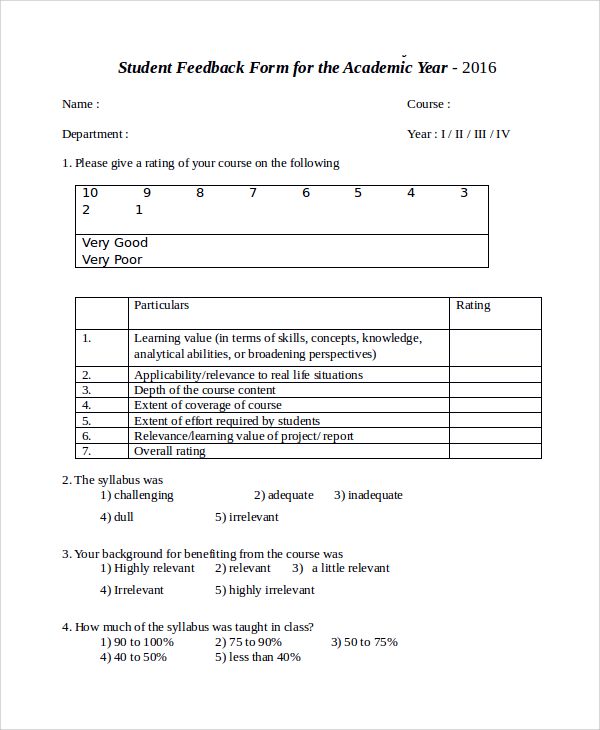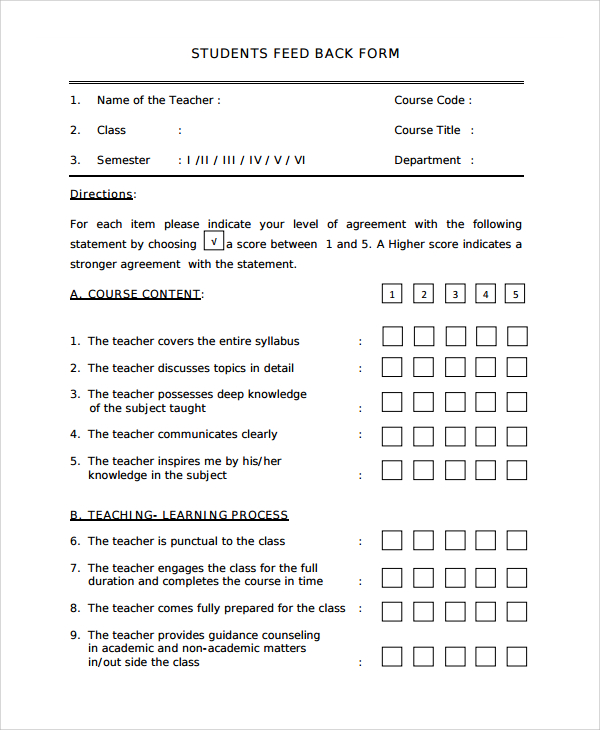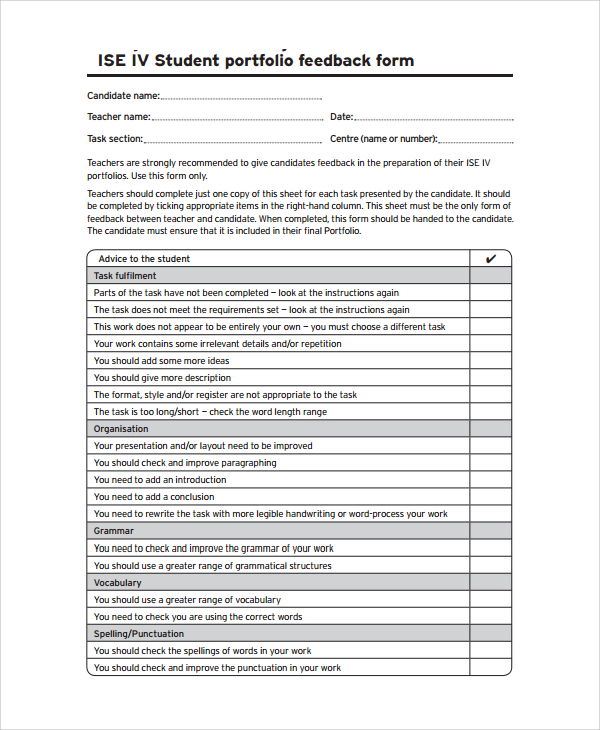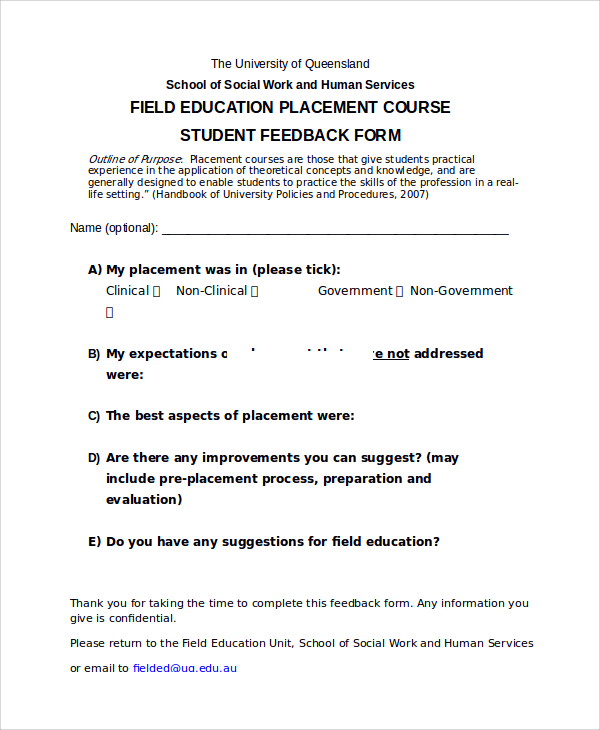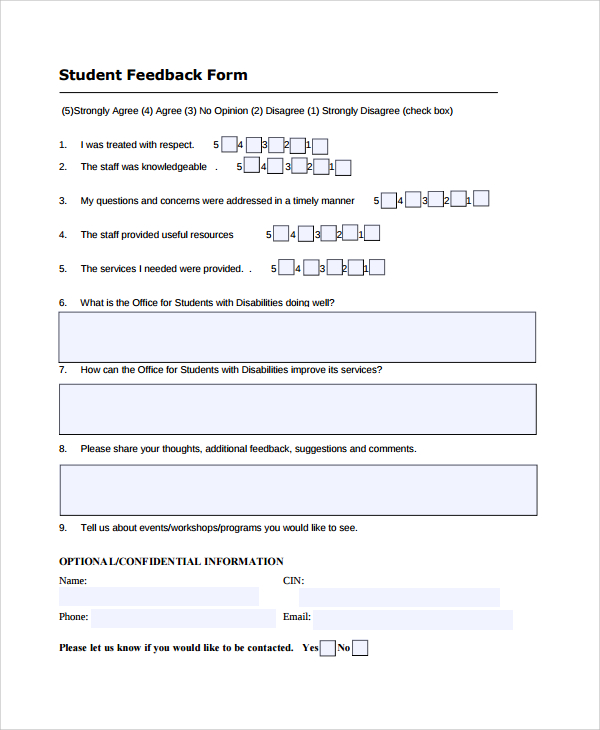A students feedback form provides information about a student’s perception of a particular teacher or a program. It’s a valuable document that helps teachers to refine their teaching. A mid-semester students feedback form has the added benefit to record students’ concerns. There are a variety of such forms, each for a particular category of student. These forms help evaluate the performance of a teacher or instructor. You may also see Service Feedback Form Templates.
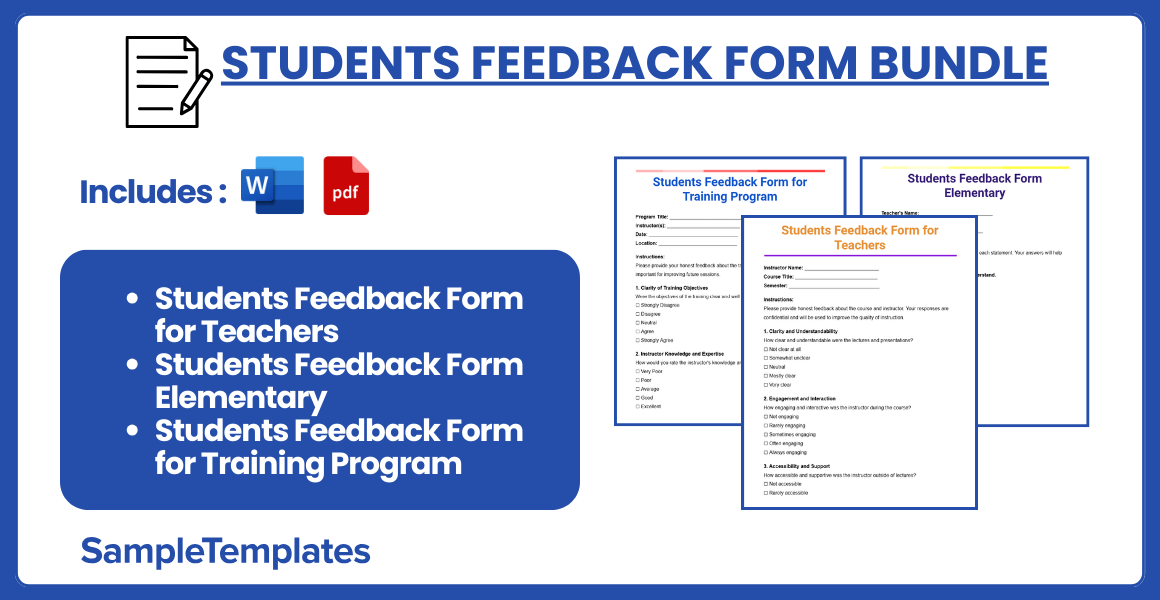
Download Students Feedback Form Bundle
Student Feedback Form for Teachers
Instructor Name: ___________________________
Course Title: ______________________________
Semester: _________________________________
Instructions:
Please provide honest feedback about the course and instructor. Your responses are confidential and will be used to improve the quality of instruction.
1. Clarity and Understandability
How clear and understandable were the lectures and presentations?
? Not clear at all
? Somewhat unclear
? Neutral
? Mostly clear
? Very clear
2. Engagement and Interaction
How engaging and interactive was the instructor during the course?
? Not engaging
? Rarely engaging
? Sometimes engaging
? Often engaging
? Always engaging
3. Accessibility and Support
How accessible and supportive was the instructor outside of lectures?
? Not accessible
? Rarely accessible
? Sometimes accessible
? Often accessible
? Always accessible
4. Use of Teaching Materials
How effectively did the instructor use teaching materials (e.g., textbooks, digital tools)?
? Not effective at all
? Slightly effective
? Moderately effective
? Very effective
? Extremely effective
5. Encouragement of Critical Thinking
How well did the instructor encourage critical thinking and problem solving?
? Not at all
? Rarely
? Sometimes
? Often
? Always
6. Overall Satisfaction
Overall, how satisfied are you with this instructor?
? Very dissatisfied
? Dissatisfied
? Neutral
? Satisfied
? Very satisfied
7. Open Feedback (Optional)
Please provide any additional comments or suggestions that may help improve this course and teaching methods.
Thank you for your feedback!
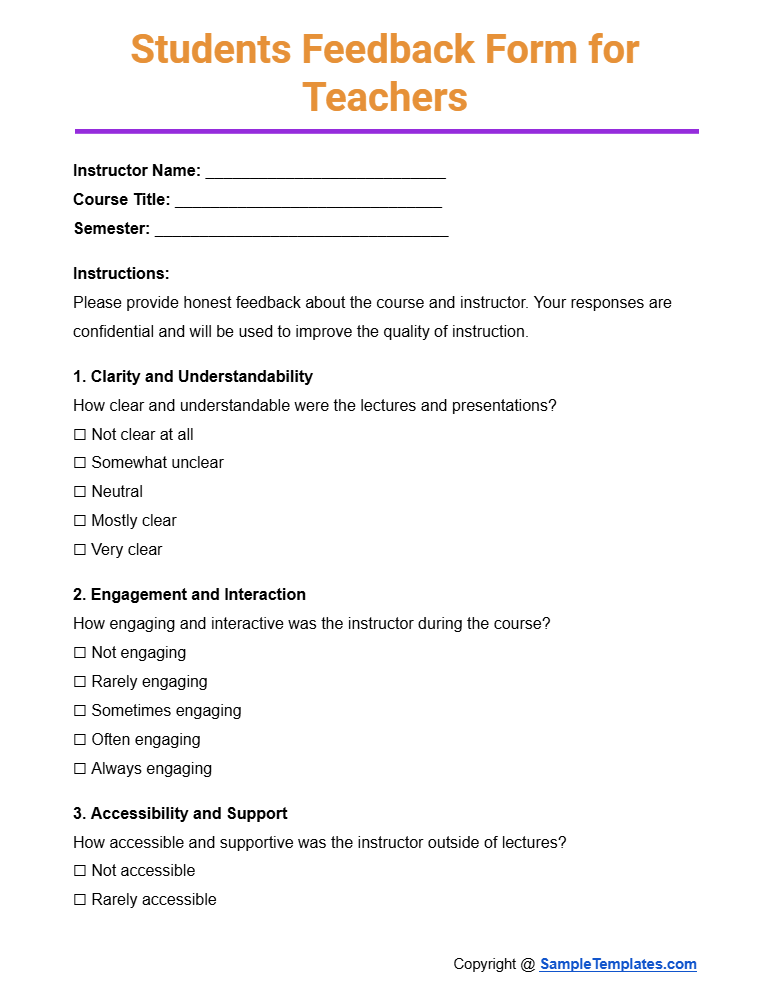
Student Feedback Form Elementary
Teacher’s Name: ___________________________
Class: ______________________________
Date: _________________________________
Instructions:
Circle the face that shows how you feel about each statement. Your answers will help your teacher make school even better!
1. My teacher explains things so I can understand.
? Very easy to understand
? Easy to understand
? Okay
? A little hard
? Very hard
2. My teacher listens to me.
? Always listens
? Usually listens
? Sometimes listens
? Rarely listens
? Never listens
3. I feel happy in class.
? Very happy
? Happy
? Okay
? A little sad
? Very sad
4. My teacher helps me when I need it.
? Always helps
? Usually helps
? Sometimes helps
? Rarely helps
? Never helps
5. Class activities are fun.
? Very fun
? Fun
? Okay
? A little boring
? Very boring
6. I feel safe in my classroom.
? Very safe
? Safe
? Okay
? A little unsafe
? Very unsafe
7. What is your favorite thing about your class?
(Write or draw in the space below)
8. What can be better in your class?
(Write or draw in the space below)
Thank you for helping us make your class better!
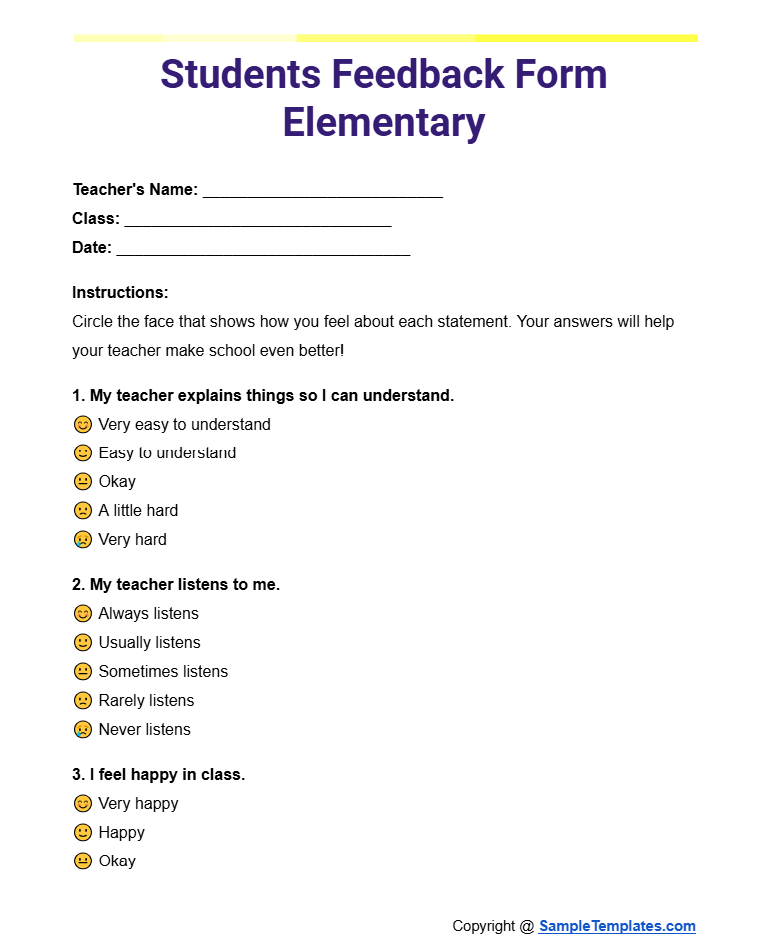
Student Feedback Form for Training Program
Program Title: ___________________________
Instructor(s): ___________________________
Date: _________________________________
Location: _____________________________
Instructions:
Please provide your honest feedback about the training program. Your responses are important for improving future sessions.
1. Clarity of Training Objectives
Were the objectives of the training clear and well defined?
? Strongly Disagree
? Disagree
? Neutral
? Agree
? Strongly Agree
2. Instructor Knowledge and Expertise
How would you rate the instructor’s knowledge and expertise on the subject matter?
? Very Poor
? Poor
? Average
? Good
? Excellent
3. Relevance of Content
How relevant was the content to your needs or expectations?
? Not relevant at all
? Slightly relevant
? Moderately relevant
? Very relevant
? Extremely relevant
4. Interaction and Participation
Was there adequate opportunity for interaction and participation?
? Strongly Disagree
? Disagree
? Neutral
? Agree
? Strongly Agree
5. Practical Application
How practical and applicable was the information presented during the training?
? Not applicable
? Slightly applicable
? Moderately applicable
? Very applicable
? Extremely applicable
6. Training Materials
How useful were the training materials provided (e.g., handouts, online resources)?
? Not useful
? Slightly useful
? Moderately useful
? Very useful
? Extremely useful
7. Overall Satisfaction
Overall, how satisfied are you with the training program?
? Very Unsatisfied
? Unsatisfied
? Neutral
? Satisfied
? Very Satisfied
8. Suggestions for Improvement
Please provide any suggestions that could make this training more effective.
9. Additional Comments
Any other comments or feedback?
Thank you for your feedback!

Browse More Templates On Student Feedback Form
School Students Feedback Form
As the name implies, a school students feedback form is submitted by students to the school authority for evaluating the performance of the teachers. Students have to fill up their names, the subject for which the teacher will be evaluated, name of the first examiner, the provisional overall grade awarded (in percentage), individual component provisional grade and similar other information.
College Students Feedback Form
In the college students feedback form, students have to enter the academic year and semester for which the sample evaluation will be carried out. Information to be entered is whether the teacher completed the full syllabus, whether other relevant topics were covered, the technical content and communication skills. Information like whether the teacher was available beyond normal class hours may also be sought. You can also see more on Seminar Feedback Forms.
Students Training Feedback Form
This sample form is usually filled up for practical training. Information sought in this form includes whether the trainer was knowledgeable, whether adequate time was provided for discussions and questions, whether subjects mentioned in the course were taught in class etc. In the end, the students have to give an overall rank to the training.
How to Make a Feedback Form for Students?
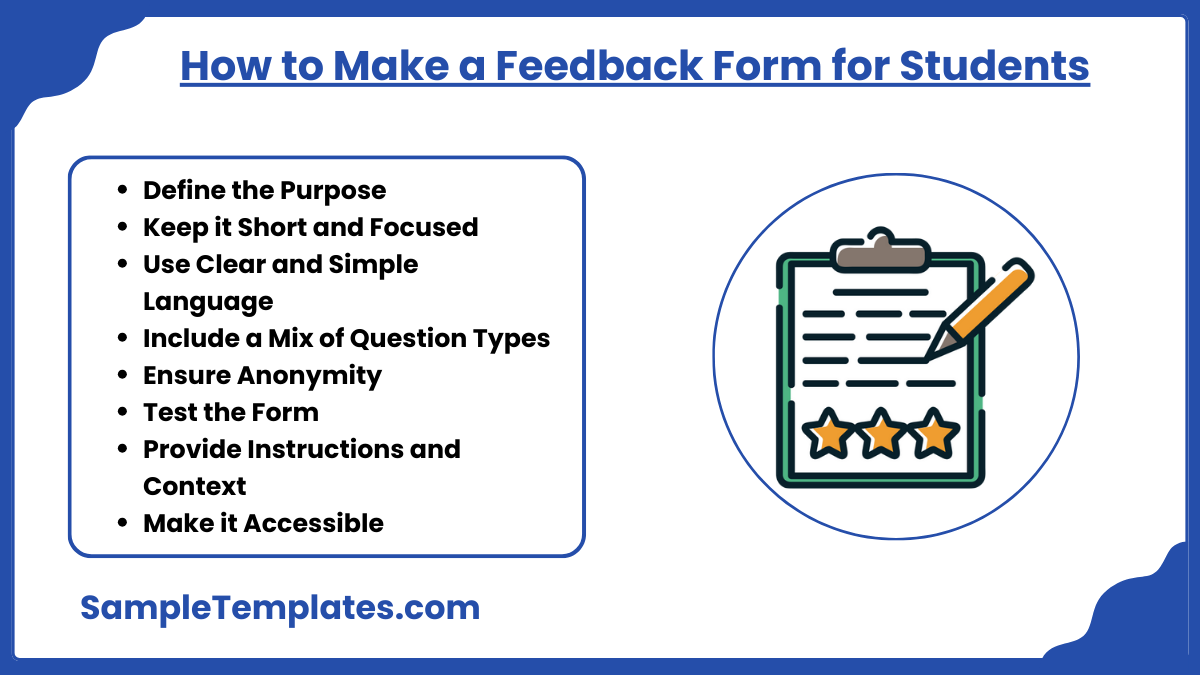
- Define the Purpose: Clearly identify what you want to learn from the feedback. This will guide the types of questions you include, whether they’re about teaching quality, course content, overall satisfaction, or specific events and activities.
- Keep it Short and Focused: Students are more likely to complete the form if it is concise. Limit the number of questions to those that are essential to meet your objectives. Ideally, a feedback form should take no more than 5-10 minutes to complete.
- Use Clear and Simple Language: Avoid jargon and complex language. Make sure the questions are easy to understand for students of all levels. This ensures that all students can provide meaningful feedback without confusion. You can also see more on Feedback Survey.
- Include a Mix of Question Types: Use a variety of question types to gather different kinds of data. Include multiple-choice questions for quantitative data, Likert scales for measuring attitudes or perceptions, and open-ended questions to allow for qualitative feedback and personal comments.
- Ensure Anonymity: Assure students that their responses will be anonymous. This encourages honesty and increases the likelihood that they will share genuine thoughts and feelings.
- Test the Form: Before distributing the form to all students, test it with a small group to catch any confusing questions or technical issues. This trial run can help you refine the questions to better meet your objectives.
- Provide Instructions and Context: At the beginning of the form, include clear instructions on how to complete it, and explain how the feedback will be used. This transparency can increase student engagement by showing that their feedback is valued and has a purpose. You can also see more on Training Feedback Forms.
- Make it Accessible: Ensure the feedback form is accessible to all students, including those with disabilities. Consider the form’s format, colors, font sizes, and the platform used to distribute and collect responses to accommodate all needs.
Primary Students Feedback Form
The primary students feedback form seeks information from students for strengthening the quality of teaching and learning environment and scouring opportunities for improving the teacher’s performance in classroom coaching. Information sought may include the teacher’s regularity and punctuality in class, sample schedule organization of class tests, assignments and quizzes, and delivery of a structured lecture.
Academic Students Feedback Form
Benefits of Students Feedback Form
- Improves Teaching Quality: Feedback forms allow teachers to gain insights into their teaching methods from the students’ perspective. This information can help educators refine their techniques, adjust their pacing, and address areas that may need improvement. You can also see more on Orientation Feedback Forms.
- Increases Student Engagement: By soliciting feedback, teachers demonstrate that they value students’ opinions, which can increase students’ engagement and investment in the course. This can lead to more active participation and a greater sense of community in the classroom.
- Enhances Course Content and Structure: Student feedback can highlight aspects of the course material that are working well or not working at all. This allows educators to tailor content to better suit the learning needs and preferences of their students, making the course more effective.
- Promotes Personalized Learning: Feedback can identify individual students’ struggles and successes, which helps teachers provide more personalized support where needed, enhancing the learning experience for each student. You can also see more on Presentation Feedback Forms.
- Encourages Reflective Teaching: Regular feedback encourages teachers to reflect on their teaching practices critically and continuously, fostering a mindset of lifelong learning and professional development.
- Measures Teaching Effectiveness: Feedback forms can be used as a tool to measure teaching effectiveness over time, which is useful for both personal career growth and institutional assessments.
- Builds Trust and Communication: When students see that their feedback is taken seriously and results in tangible changes, it builds trust and opens lines of communication between students and educators, leading to a more positive classroom environment.
- Facilitates Accreditation and Compliance: In many educational systems, gathering student feedback is a requirement for accreditation. These forms provide documented evidence that educators and institutions are actively engaging with students and committed to improving educational practices.
Sample Students Feedback Form
University Students Feedback Form
Students Portfolio Feedback Form
Use of Students Feedback Form
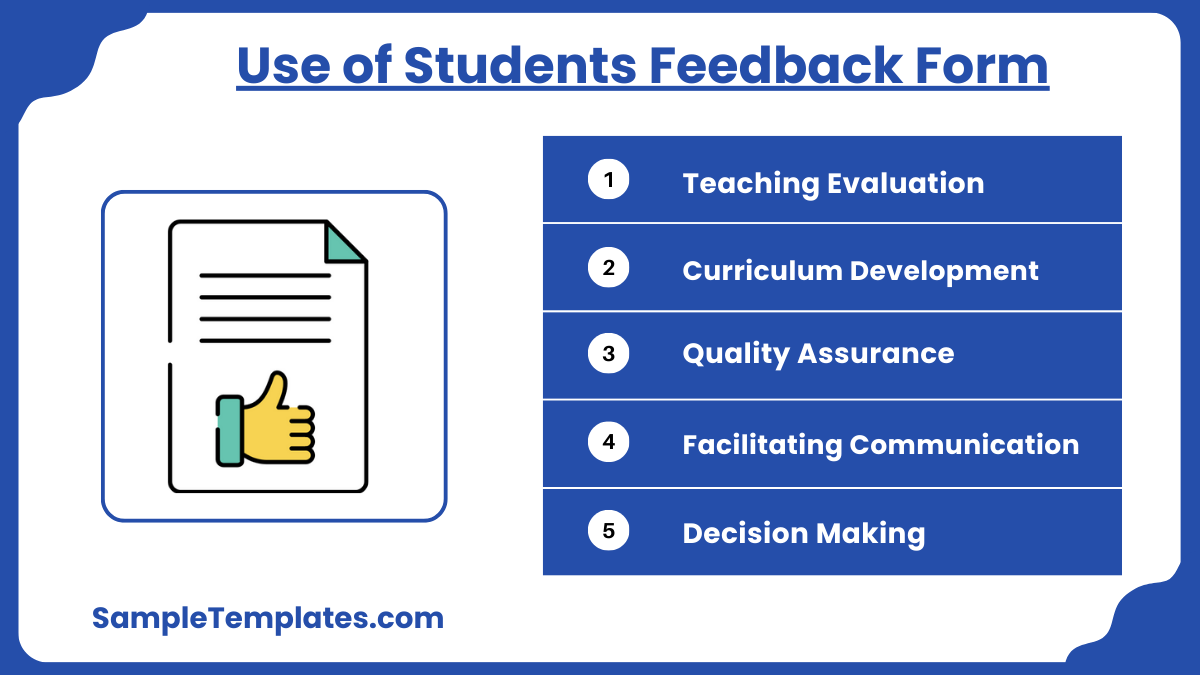
- Teaching Evaluation: Feedback forms are commonly used to assess the effectiveness of teaching methods and instructors. They help gather students’ perceptions about clarity of instruction, engagement, and the instructor’s knowledge and responsiveness.
- Curriculum Development: Student feedback is crucial for curriculum development. It helps educational institutions understand what works and what doesn’t, allowing for the adaptation of course content to better meet student needs and industry trends.
- Quality Assurance: Feedback forms are a key tool in quality assurance processes within educational settings. They provide data that can be analyzed to ensure that the education provided meets or exceeds the required standards. You can also see more on Tutor Evaluation Form.
- Student Engagement and Satisfaction: These forms can measure how engaged and satisfied students are with their courses, which is vital for improving student retention rates and overall educational experience.
- Personal Development for Educators: Educators can use the feedback for personal and professional development, identifying areas for improvement and tracking progress over time.
- Accreditation and Compliance: For many educational programs, gathering feedback from students is a requirement for accreditation. Feedback forms provide evidence that the institution values and acts upon the input of its students.
- Facilitating Communication: They open a formal line of communication between students and faculty, allowing students to express concerns and suggestions that they might not feel comfortable sharing in person.
- Decision Making: Administrators use the aggregated data from feedback forms to make informed decisions about staffing, resources, and policies, ensuring that decisions are data-driven and aligned with the needs of the student body. You can also see more on Event Feedback Forms.
Students Course Feedback Form
Student Feedback Form Example
What should a good feedback form include?
Clear questions, a mix of quantitative and qualitative options, anonymity assurance, specific items, simplicity in language, instructions, and a section for general comments or suggestions. You can also see more on Speaker Feedback Forms.
What do you say in a feedback form?
Provide honest, specific feedback. Address the clarity, effectiveness, and engagement of the content or instructor. Suggest improvements and mention aspects that worked well. Be respectful and constructive.
What kind of feedback should be given to students?
Feedback should be specific, actionable, positive, and constructive. Focus on behaviors and strategies rather than personal attributes. Emphasize growth and learning to motivate and guide improvement.
If you have any DMCA issues on this post, please contact us!
Related Posts
Vehicle Inspection Forms Samples & Templates
Sample Employee Advance Forms
Sample Child Travel Consent Forms
Sample Testimonial Request Forms
Sample Employee Details Forms
Sample Divorce Forms
Sample Attestation Forms
Employee Performance Appraisal Form Templates
FREE 9+ Sample Presentation Evaluation Forms in MS Word
FREE 10+ School Admission Form Samples & Templates in MS Word | PDF
FREE 30+ Patient Consent Form Samples in PDF | MS Word
FREE 10+ Sample Sign Off Form Templates in PDF | MS Word
FREE 11+ Sample Medical Consultation Forms in PDF | MS Word
FREE 8+ Sample Donation Forms in PDF | MS Word
FREE 20+ Peer Review Form Samples in PDF
